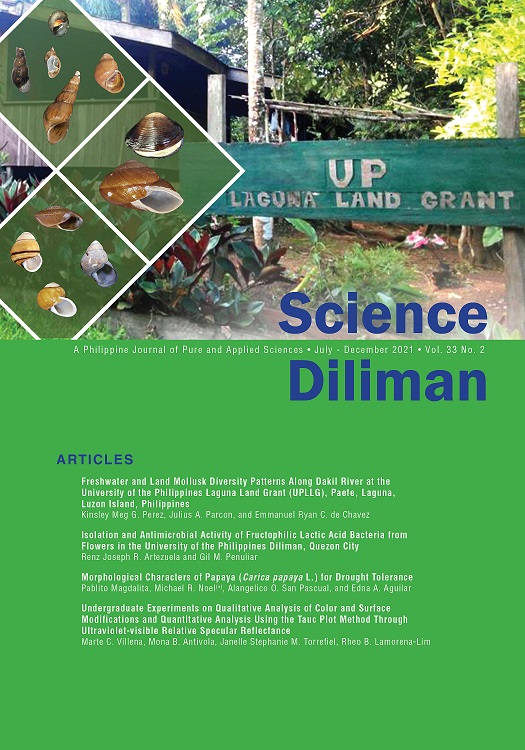Freshwater and Land Mollusk Diversity Patterns Along Dakil River at the University of the Philippines Laguna Land Grant (UPLLG), Paete, Laguna, Luzon Island, Philippines
Abstract
Prior to this study, there had been no malacofaunal study in the University of the Philippines Laguna Land Grant (UPLLG). To address this, a diversity survey of its freshwater and land mollusks was conducted. A total of 25 quadrats (15 m2) on upstream and downstream stations along Dakil River and its tributaries for freshwater mollusks and 12 quadrats (100 m2) for land snails were set randomly to correlate their diversity patterns with environmental variables. From 115 individuals of freshwater mollusks, seven species (six gastropods, one bivalve) belonging to six families (Ampullariidae, Corbiculidae, Lymnaeidae, Neritinidae, Thiaridae, and Viviparidae) were identified. On the other hand, seven species belonging to three families (Ariophantidae, Camaenidae, and Chronidae) were identified among 28 land snail individuals. Malacofaunal survey revealed that the area along Dakil River has low diversity in both freshwater mollusk (H’=1.40) and land snail (H’=1.19). Generalized linear mixed models (GLMM) revealed river velocity was the most significant predictor for species richness of freshwater mollusks, and abundance was highly affected by temperature and inversely affected by canopy cover. Furthermore, altitude was the most significant predictor for species richness of land snails and canopy cover for abundance. Understanding the molluscan diversity could help determine the environment and ecological conditions of the watershed for its effective management and conservation.
Published
2022-04-28
How to Cite
PEREZ, Kinsley Meg G.; PARCON, Julius A.; DE CHAVEZ, Emmanuel Ryan C..
Freshwater and Land Mollusk Diversity Patterns Along Dakil River at the University of the Philippines Laguna Land Grant (UPLLG), Paete, Laguna, Luzon Island, Philippines.
Science Diliman: A Journal of Pure and Applied Sciences, [S.l.], v. 33, n. 2, apr. 2022.
ISSN 2012-0818.
Available at: <https://journals.upd.edu.ph/index.php/sciencediliman/article/view/8775>. Date accessed: 05 sep. 2025.
Issue
Section
Articles
Keywords
Diversity, freshwater mollusks, land snails, Dakil River, species richness, abundance
Submission of a manuscript implies: that the work described has not been published before (except in the form of an abstract or as part of a published lecture, review, or thesis); that it is not under consideration for publication elsewhere; that its publication has been approved by all co-authors, if any, as well as by the responsible authorities at the institute where the work has been carried out; that, if and when the manuscript is accepted for publication, the authors agree to the automatic transfer of the copyright to the publisher; that the manuscript will not be published elsewhere in any language without the consent of the copyright holders; that written permission of the copyright holder is obtained by the authors for material used from other copyrighted sources; and that any costs associated with obtaining this permission are the authors’ responsibility.



